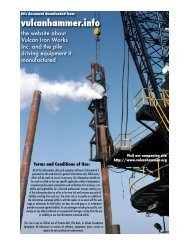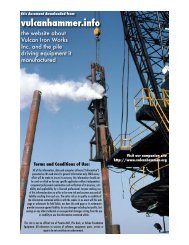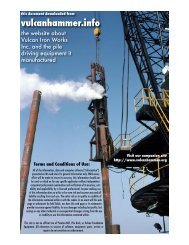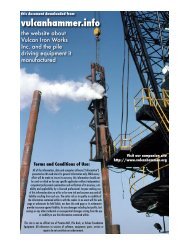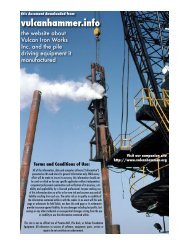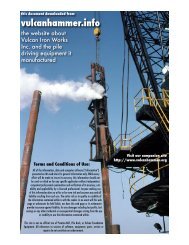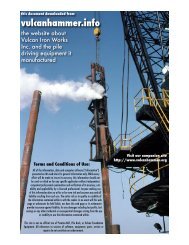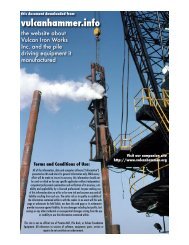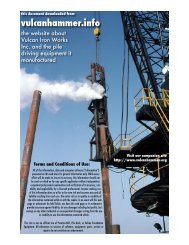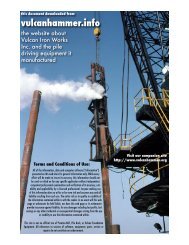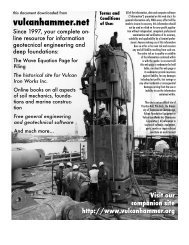comparison of numerical methods to closed form solution for wave ...
comparison of numerical methods to closed form solution for wave ...
comparison of numerical methods to closed form solution for wave ...
Create successful ePaper yourself
Turn your PDF publications into a flip-book with our unique Google optimized e-Paper software.
This document downloaded fromvulcanhammer.netsince 1997,your source <strong>for</strong> engineering in<strong><strong>for</strong>m</strong>ation<strong>for</strong> the deep foundation and marineconstruction industries, and the his<strong>to</strong>ricalsite <strong>for</strong> Vulcan Iron Works Inc.Use subject <strong>to</strong> the “fine print” <strong>to</strong> theright.All <strong>of</strong> the in<strong><strong>for</strong>m</strong>ation, data and computer s<strong>of</strong>tware("in<strong><strong>for</strong>m</strong>ation") presented on this web site is <strong>for</strong>general in<strong><strong>for</strong>m</strong>ation only. While every ef<strong>for</strong>t willbe made <strong>to</strong> insure its accuracy, this in<strong><strong>for</strong>m</strong>ationshould not be used or relied on <strong>for</strong> any specificapplication without independent, competentpr<strong>of</strong>essional examination and verification <strong>of</strong> itsaccuracy, suitability and applicability by a licensedpr<strong>of</strong>essional. Anyone making use <strong>of</strong> thisin<strong><strong>for</strong>m</strong>ation does so at his or her own risk andassumes any and all liability resulting from suchuse. The entire risk as <strong>to</strong> quality or usability <strong>of</strong> thein<strong><strong>for</strong>m</strong>ation contained within is with the reader. Inno event will this web page or webmaster be heldliable, nor does this web page or its webmasterprovide insurance against liability, <strong>for</strong> anydamages including lost pr<strong>of</strong>its, lost savings or anyother incidental or consequential damages arisingfrom the use or inability <strong>to</strong> use the in<strong><strong>for</strong>m</strong>ationcontained within.This site is not an <strong>of</strong>ficial site <strong>of</strong> Prentice-Hall, theUniversity <strong>of</strong> Tennessee at Chattanooga, VulcanFoundation Equipment or Vulcan Iron Works Inc.(Tennessee Corporation). All references <strong>to</strong>sources <strong>of</strong> equipment, parts, service or repairs donot constitute an endorsement.Don’t <strong>for</strong>get <strong>to</strong> visit our companion site http://www.vulcanhammer.org
COMPARISON OF NUMERICAL METHODS TOCLOSED FORM SOLUTION FOR WAVE EQUATIONANALYSIS OF PILING 1AbstractDon C. Warring<strong>to</strong>n 2 and Robert H. Wynn 3This paper documents both the development <strong>of</strong> a <strong>closed</strong> <strong><strong>for</strong>m</strong> <strong>solution</strong> <strong>for</strong> the one-dimensional <strong>wave</strong>equation as it is applied <strong>to</strong> piles and its <strong>comparison</strong> <strong>to</strong> <strong>numerical</strong> <strong>solution</strong>s <strong>of</strong> the same problem. Wavemechanics have been used extensively in piles <strong>for</strong> many years but the <strong>solution</strong> <strong>of</strong> the <strong>wave</strong> equation hasbeen almost exclusively a <strong>numerical</strong> one. The <strong>closed</strong> <strong><strong>for</strong>m</strong> <strong>solution</strong> used involves the <strong>solution</strong> <strong>of</strong> thesemi-infinite pile <strong>solution</strong> immediately after impact and a Fourier series <strong>solution</strong> <strong>for</strong> times thereafter.This <strong>solution</strong> is compared with <strong>numerical</strong> <strong>solution</strong>s <strong>of</strong> different kinds <strong>for</strong> a given test case. The<strong>comparison</strong> shows variations between the <strong>closed</strong> <strong><strong>for</strong>m</strong> <strong>solution</strong> and the <strong>numerical</strong> <strong>methods</strong> that,although not egregious, are also not consistent from case <strong>to</strong> case. A wider variety <strong>of</strong> cases is needed <strong>to</strong>come <strong>to</strong> more general conclusions about the variations in these <strong>methods</strong>.IntroductionWave mechanics have been employed <strong>for</strong> the analysis <strong>of</strong> piles during impact driving <strong>for</strong> the last <strong>for</strong>tyyears. Many algorithms have been developed <strong>to</strong> per<strong><strong>for</strong>m</strong> this analysis, starting with Smith (1960). Any<strong>numerical</strong> method, however, will have inherent characteristics which will degrade its modelling <strong>of</strong> theactual physical system. These limitations have been documented in the past (Van Weele and Kay,1984; Warring<strong>to</strong>n, 1997), but are not widely appreciated by many users <strong>of</strong> the programs. The purpose<strong>of</strong> this paper is <strong>to</strong> compare results from some <strong>of</strong> these <strong>methods</strong> <strong>to</strong> a new <strong>closed</strong> <strong><strong>for</strong>m</strong> <strong>solution</strong> <strong>of</strong> the<strong>wave</strong> equation <strong>for</strong> piles. This will both highlight the differences in the <strong>methods</strong> and make <strong>for</strong> a greaterunderstanding <strong>of</strong> the limitations <strong>of</strong> <strong>numerical</strong> <strong>methods</strong>.1 Presented at the Thirteenth Annual Meeting <strong>of</strong> the Tennessee Section <strong>of</strong> the American Society <strong>of</strong> Civil Engineers, Smyrna,Tennessee, November 3, 2000. Published online at The Wave Equation Page <strong>for</strong> Piling. All <strong>of</strong> the in<strong><strong>for</strong>m</strong>ation, data andcomputer s<strong>of</strong>tware ("in<strong><strong>for</strong>m</strong>ation") presented on this web site is <strong>for</strong> general in<strong><strong>for</strong>m</strong>ation only. While every ef<strong>for</strong>t will be made<strong>to</strong> insure its accuracy, this in<strong><strong>for</strong>m</strong>ation should not be used or relied on <strong>for</strong> any specific application without independent,competent pr<strong>of</strong>essional examination and verification <strong>of</strong> its accuracy, suitability and applicability by a licensed pr<strong>of</strong>essional.Anyone making use <strong>of</strong> this in<strong><strong>for</strong>m</strong>ation does so at his or her own risk and assumes any and all liability resulting from suchuse. The entire risk as <strong>to</strong> quality or usability <strong>of</strong> the in<strong><strong>for</strong>m</strong>ation contained within is with the reader. In no event will thisweb page or webmaster be held liable, nor does this web page or webmaster provide insurance against liability, <strong>for</strong> anydamages including lost pr<strong>of</strong>its, lost savings or any other incidental or consequential damages arising from the use or inability<strong>to</strong> use the in<strong><strong>for</strong>m</strong>ation contained within.2 Independent Consultant3 Associate Pr<strong>of</strong>essor (Retired), University <strong>of</strong> Tennessee at Chattanooga
Outline <strong>of</strong> Closed Form SolutionThe <strong>closed</strong> <strong><strong>for</strong>m</strong> <strong>solution</strong> used is the <strong>solution</strong> as proposed by Warring<strong>to</strong>n (1997). An outline <strong>of</strong> this<strong>solution</strong> method follows.Basic Solution Method1. Determine the <strong>for</strong>ce-time or displacement-time his<strong>to</strong>ry <strong>of</strong> the hammer at the pile <strong>to</strong>p, either usingsemi-infinite pile theory or actual field data.2. Solve the <strong>wave</strong> equation <strong>for</strong> the semi-infinite pile case. This is the <strong>solution</strong> <strong>for</strong> t < L/c, i.e., be<strong>for</strong>ethe <strong>wave</strong> front propagates <strong>to</strong> the pile <strong>to</strong>e.3. Compute the displacement and velocity functions as a function <strong>of</strong> distance at t = L/c. Thesebecome the initial conditions <strong>for</strong> the remainder <strong>of</strong> the problem.4. Using the boundary conditions, compute the eigenvalues and eigenfunctions <strong>for</strong> the Fourier series.The pile <strong>to</strong>p is assumed <strong>to</strong> be a free end in this case.5. Using the displacement and velocity functions at t = L/c, compute the Fourier coefficients. ThisFourier series is the <strong>solution</strong> <strong>for</strong> t > L/c.As stated, this procedure assumes the transition point <strong>to</strong> be fixed at t = L/c. However, if the impulse<strong>for</strong>ce <strong>of</strong> the hammer system ends be<strong>for</strong>e this time, it is most advantageous <strong>to</strong> make the turnover pointat the time when the impulse <strong>for</strong>ce becomes zero, or tension begins <strong>to</strong> develop in the pile <strong>to</strong>p.Assumptions <strong>for</strong> the SolutionThe following assumptions are made:1. The <strong>solution</strong> must be reasonably simple; the <strong>solution</strong> must not require integration or othertrans<strong><strong>for</strong>m</strong>ation once it is <strong><strong>for</strong>m</strong>ulated.2. The system is a linear system. No plasticity is taken in<strong>to</strong> account in this system.3. All properties between the boundaries are uni<strong><strong>for</strong>m</strong>. These include pile area and material,dampening, soil spring constant.4. Extensibility considerations <strong>of</strong> the pile <strong>to</strong>p and <strong>to</strong>e are not significant. The validity <strong>of</strong> thisassumption is dependent upon how the pile <strong>to</strong>p <strong>for</strong>ce is <strong><strong>for</strong>m</strong>ulated.5. The <strong>for</strong>ce <strong>of</strong> the hammer is substantially finished be<strong>for</strong>e t = L/c. This <strong>solution</strong> favours long pilesrelative <strong>to</strong> the hammer blow duration.2
Solution <strong>of</strong> the Wave EquationThe system being modelled is shown in Figure 1.The hammer has a rigid mass with a perfectly elasticcushion and another rigid mass <strong>to</strong> represent the pilecap. In this case the pile shaft has no soil interactionand the <strong>to</strong>e has only elasticity without dampening <strong>of</strong>any kind. The system is completely linear. Althoughdampening can be included in the hammer cushion,pile shaft and pile <strong>to</strong>e, and distributed elasticity alongthe shaft, these elements were left out both <strong>for</strong> thesimplicity <strong>of</strong> the <strong>closed</strong> <strong><strong>for</strong>m</strong> <strong>solution</strong> and <strong>to</strong> examinespecific difficulties with the <strong>numerical</strong> <strong>methods</strong>, suchas difficulties with <strong>numerical</strong> <strong>methods</strong>, inaccuraciesdue <strong>to</strong> discretisation, and instabilities caused byboundary conditions.The basic equation <strong>for</strong> the system is( , ) ( , )u x t c u x ttt= 2 ..................................(1)xxwhere c = Acoustic Speed <strong>of</strong> Pile Material, m/sec, = Displacement <strong>of</strong> Pile Particle, mu( x t)t = Time from Zero Point, secondsx = Distance from Pile Top, mThe initial conditions are( ) f ( x)u x,0 = = 0 ...............................................................................................................................(2)KmK pHammer CushionPile CapPile Toe SpringFigure 1 Hammer-Pile-Soil Systemand( ) g( x)ut x,0 = = 0 .................................................................................................................................(3)where f ( x ) = Initial Displacement Distribution in Pile, mg( x ) = Initial Velocity Distribution in Pile, m/secThe boundary condition <strong>for</strong> the pile <strong>to</strong>e is( L, t) = K u( L t)− EAu....................................................................................................................(4)x t,where E = Young’s Modulus <strong>for</strong> the pile, PaA = Pile cross-sectional area, m 2K t = Soil Toe Spring or Elastic Constant, N/mL = Length <strong>of</strong> Pile, m3
Be<strong>for</strong>e t= L c, the boundary condition <strong>for</strong> the pile <strong>to</strong>p isu( 0, t) = f ( t)........................................................................................................................................(5)where ( ) f t = Displacement-time his<strong>to</strong>ry <strong>of</strong> pile <strong>to</strong>p, mand after this timeu ( 0, xt)= 0...........................................................................................................................................(6)Solution <strong>of</strong> the Impact Hammer ForceTo establish an expression <strong>for</strong> ( ) f t , we will use semi-infinite pile theory (Parola, 1970). The equations<strong>of</strong> motion <strong>for</strong> the ram and pile cap, respectively, are( )Mx′′+ K x − x = 0 ...........................................................................................................................(7)r r tand( )mx + Zx′ + K x − x = 0 ................................................................................................................(8)t t t rwhere x r= Displacement <strong>of</strong> ram, mx t= Pile Top Displacement, mM = Ram Mass, kgK = Hammer cushion stiffness, N/mm = Pile Cap Mass, kgZ = Pile Impedance, M-sec/mDeeks and Randolph (1993) solved this system <strong>of</strong> equations. The resulting displacement-time his<strong>to</strong>ry atthe pile <strong>to</strong>p can be applied <strong>to</strong> the rest <strong>of</strong> the semi-infinite pile by the equation (Kreyszig, 1993)xu( x t)f tc H t x, = ⎛ ⎞ ⎛ ⎞⎜ − ⎟ ⎜ − ⎟ ..................................................................................................................(9)⎝ ⎠ ⎝ c⎠where ⎛H t − x⎞⎜ ⎟, ( )⎝ c⎠H t = Heaviside Step FunctionIf we substitute the expressionsω 1=KM........................................................................................................................................... (10)KEA Zcp= = ...................................................................................................................................... (11)L L4
ω 2= c L............................................................................................................................................ (12)( ) f t= x t ......................................................................................................................................... (13)where ω 1= Natural frequency <strong>of</strong> hammer-cushion system, rad/secω 2 = Natural frequency <strong>of</strong> pile, rad/secK p = Pile static stiffness, N/mand apply the <strong>solution</strong> <strong>to</strong> Equations (7) and (8) <strong>for</strong> the pile <strong>to</strong>p <strong>to</strong> Equation (9), the displacement <strong>for</strong>the pile be<strong>for</strong>e t = L/c is( , )u x tV Mωm=20 1⎛⎛⎜⎜e⎜⎜⎜⎝⎜⎜⎜ α⎜e⎜⎜⎝⎛ x ⎞α 1 ⎜ t − ⎟⎝ Lω2 ⎠⎛ x ⎞2 ⎜ t − ⎟⎝ Lω2 ⎠⎞⎞− ⎟( 2 21 α3+ α3α) +⎟2⎟⎟⎠⎟⎛ ⎛ ⎛ x ⎞⎞ ⎞⎟ .................................. (14)2 22⎜sin⎜α3⎜t− ⎟( α1α 2− α1α2 − α1α) ⎟ ⎟⎟3⎜ ⎝ ⎝ Lω2⎠⎠ ⎟⎟⎜⎟⎟⎜ ⎛ ⎛ ⎛ x ⎞⎞⎞⎟⎟⎜ + ⎜cos⎜α⎜t− ⎟⎟ −31 ( )⎝ ⎝ ⎝ L ⎠⎠⎟α 23α1− 2α1α 2α3⎟⎝ω2⎠⎠⎟⎠ ⎛ x ⎞H⎜t− ⎟2 2 22 2α α α + α α − 2α α + α + α ⎝ Lω⎠( 1 3( 2 3 )( 1 1 2 2 3 ))2and the velocityut( x,t)V Mωm20 1=⎛ x ⎞⎛ α 1 ⎜ t − ⎟⎜⎝ Lω2 ⎠ 22α1e( α3+ α3α2) +⎜⎜⎛ ⎛ ⎛⎜⎜αcos⎜3α3⎜t−⎜⎜ ⎝ ⎝⎜⎜⎜⎜ ⎛ ⎛ ⎛⎜ e ⎜ + ⎜sin⎜α3⎜t −⎜⎜ ⎝ ⎝ ⎝⎜⎜⎜⎜⎝⎝xLω⎛ x ⎞α 2 ⎜ t − ⎟⎞⎞⎝ Lω2 ⎠⎟⎟ − 1xLω2( α α − α α )( 1 2 3+ − ( + ))23 2 2α α α α 21α2α1α2α322⎞⎟⎠⎠⎠1 2⎞⎟⎠1 32 2 22 2( 1 3( 2+3 )( 1− 21 2+2+3 ))⎞⎟⎟⎟⎟⎟⎟⎟⎟⎟⎟⎞⎞⎟⎟⎠⎟⎟⎟⎟⎟⎟⎟⎠⎟⎠⎛ xH⎜x −α α α α α α α α α ⎝ Lω2⎞⎟⎠......................... (15)whereα1=α4− 2K6mω2p−2α35.................................................................................................................. (16)5
α2α4+ 4Kp α5= − +12mω32.................................................................................................................. (17)α32 ⎛ α42α⎞5= ⎜ + ⎟3 ⎝ 6mω3 ⎠2................................................................................................................... (18)α4=32 2 2 2 2 336K mMω ω − 72K m ω ω − 8K+p 1 2p 1 2 p12 3ω ω m1 243 24( ω1ω2 ) mM 12ω1ω222 24( ω1ω2) M Kp12( ω1ω2)2220( ω ω ) mMK 4( ω ω m)1 2( ω1ω2mKp )8 + 4K22 2 2+ −3+ −p4p1 2m Mm M4+ +.............................................. (19)α5=2( ω ω ) ( ω ω )2 42 331 2mM + 31 2m − Kp..................................................................... (20)mω αIf these equations are evaluated at t = L/c, they become the initial conditions f(x) and g(x) <strong>for</strong> theFourier series. For the time t > L/c, the <strong>solution</strong> is∞⎛ λnx⎞⎛⎛ ⎛ L⎞⎞⎛u( x, t)= ∑ cos⎜⎟⎜Ccos⎜λnω⎜t− ⎟⎟ + C sin⎜λnω⎝ L ⎠⎝⎝ ⎝ c ⎠⎠⎝n=11 2 2 2⎛⎜t−⎝Lc⎞⎞⎞⎟⎟⎟..................... (21)⎠⎠⎠and∞⎛ λnx⎞⎛⎛ ⎛ L⎞⎞⎛ut( x, t)= ω ∑λncos⎜⎟⎜−C sin⎜λ nω⎜t− ⎟⎟ + C cos⎜λnω⎝ L ⎠⎝⎝ ⎝ c ⎠⎠⎝2 1 2 2 2n=1⎛ L⎞⎞⎞⎜t− ⎟⎟⎟⎝ c ⎠⎠⎠..................... (22)The coefficients C 1 and C 2 are evaluated using the initial conditions given above according <strong>to</strong> themethod <strong>of</strong> Tols<strong>to</strong>v (1962); an example <strong>of</strong> this <strong>for</strong> a similar case is given by Warring<strong>to</strong>n (1997). Thecoefficients are omitted <strong>for</strong> brevity, as they are extremely involved. More important are theeigenvalues; they are the <strong>solution</strong> <strong>of</strong> the equation1 Ks⎛ 3⎞⎛ 1⎞tan ( λn) = , π ⎜n − ⎟ < λn< π ⎜n − ⎟ , n = 1, 2, 3 ,... ∞ ............................. (23)λ K ⎝ 2⎠⎝ 2⎠np6
Direct Stiffness Solution using ANSYS-ED 5.3 with CommercialLicenseOne interesting concept that has not been widely pursued either by researchers or practitioners hasbeen the use <strong>of</strong> general purpose finite element codes <strong>for</strong> stress <strong>wave</strong> analysis <strong>of</strong> piles. For bothundamped and damped cases the <strong>closed</strong> <strong><strong>for</strong>m</strong> <strong>solution</strong> was compared with results from the ANSYSgeneral purpose computer program. The pile <strong>to</strong>p <strong>for</strong>ce can be simulated either by applying a <strong>for</strong>ce-timerelationship or simulating the drop <strong>of</strong> a mass on<strong>to</strong> the hammer cushion. Both <strong>of</strong> these were modelledin ANSYS <strong>for</strong> this paper.Finite Difference Solution using WEAP87From both an his<strong>to</strong>rical and a practical standpoint, the most important <strong>comparison</strong> is with the finitedifference techniques that have been the industry standard since the days <strong>of</strong> Smith (1960). For thispurpose the WEAP87 program was used. This is similar <strong>to</strong> the WEAP86 program as described byGoble and Rausche (1986). This program has a relatively undemanding personal computerimplementation and many options <strong>for</strong> input and output. These are necessary in this case as the entry<strong>of</strong> soil parameters that are similar <strong>to</strong> those used in the <strong>closed</strong> <strong><strong>for</strong>m</strong> <strong>solution</strong> require some care becausetheir theoretical basis is different..Example Case <strong>for</strong> Comparison PurposesStatement <strong>of</strong> the ProblemThe basic problem under consideration is the driving <strong>of</strong> a 1000 mm diameter steel pipe pile, 50 m long,with a wall thickness <strong>of</strong> 40 mm. The hammer used has a ram mass <strong>of</strong> 15 metric <strong>to</strong>ns; it has anequivalent stroke <strong>of</strong> 1.5 m and a mechanical efficiency <strong>of</strong> 80%. The cushion block has a stiffness <strong>of</strong>2.45 GN/m and has no damping. All <strong>of</strong> the soil resistance is represented as an elastic spring at the pile<strong>to</strong>e; its stiffness is the same as the pile’s. This example was analysed <strong>for</strong> 0 < t < 4L/c <strong>for</strong>displacement-time and <strong>for</strong>ce-time his<strong>to</strong>ries at the pile <strong>to</strong>p (L = 0 m), pile middle (L = 25 m) and pile<strong>to</strong>e (L = 50m).Values <strong>for</strong> the variables <strong>of</strong> the <strong>solution</strong> are shown in Warring<strong>to</strong>n (1997). These are either givenvariables or computed using the appropriate equations given earlier.Computation <strong>of</strong> Pile Top Force and DisplacementThe <strong>closed</strong> <strong><strong>for</strong>m</strong> <strong>solution</strong> is dependent upon the function <strong>of</strong> the pile <strong>to</strong>p <strong>for</strong>ce, as is the Newmarkmethod using Maple V and most <strong>of</strong> the ANSYS runs.For the case considered, the displacement-time his<strong>to</strong>ry <strong>for</strong> this is what is derived in the <strong>closed</strong>-<strong><strong>for</strong>m</strong><strong>solution</strong>. Substituting the variables and solving <strong>for</strong> x=0, the result isf ( t)=−. 0149−. 01339e . t −−. 00151e . t −cos ( 4016678 . t) −. 0293e . tsin ( 4016678 . t)835 176 396 154 396 154................... (26)However, <strong>for</strong> both the Newmark’s Solution using Maple V and the ANSYS <strong>solution</strong> using an applied<strong>for</strong>ce, it is more convenient <strong>to</strong> use a <strong>for</strong>ce-time his<strong>to</strong>ry rather than a displacement-time his<strong>to</strong>ry. Thiscan be found by multiplying the result <strong>of</strong> Equation (15) by the pile impedance and substituting again x= 0. In this case the <strong>for</strong>-time his<strong>to</strong>ry at the pile <strong>to</strong>p is8
( )F t0=−( e t −e t −( t ) e t ( t)6 835. 176 396. 154 6 396. 154 .................. (27)54. 61× 10 − cos 4016678 . + 59. 69 × 10 sin 4016678 .Two items need <strong>to</strong> be noted <strong>for</strong> these results:• The semi-infinite pile <strong>to</strong>p <strong>for</strong>ce-time curve is substantially complete at about t = L/c, so thiscriterion <strong>of</strong> the <strong>closed</strong> <strong><strong>for</strong>m</strong> <strong>solution</strong> is met.• The negative portions are physically impossible because the hammer cushion is inextensible;however, these are not very significant.Presentation and Discussion <strong>of</strong> the ResultsBecause <strong>of</strong> the nature <strong>of</strong> the results, graphical <strong>comparison</strong> is the most expedient method <strong>to</strong> view theseresults. The displacement-time and <strong>for</strong>ce-time his<strong>to</strong>ries are compared in two ways: a) between differingplaces on the pile <strong>for</strong> a single method, and b) between <strong>methods</strong> <strong>for</strong> given points on the pile.General CommentsIn comparing the results, the first thing that needs <strong>to</strong> be observed is that the <strong>solution</strong> <strong>methods</strong> can begrouped in several ways. These groupings are important <strong>to</strong> understand in order <strong>to</strong> properly interpret theresult.Type <strong>of</strong> Solution: The two-stage <strong>closed</strong> <strong><strong>for</strong>m</strong> <strong>solution</strong> is obviously the only <strong>solution</strong> <strong>of</strong> its type, asopposed <strong>to</strong> the other, <strong>numerical</strong> <strong>solution</strong>s. However, the <strong>numerical</strong> <strong>solution</strong>s themselves are different,as Newmark’s Solution using Maple V and ANSYS are one the one hand finite element <strong>solution</strong>s andWEAP87 is a finite difference <strong>solution</strong>.Pile Top Loading: The <strong>closed</strong> from <strong>solution</strong> uses Equation (26) <strong>for</strong> the pile <strong>to</strong>p displacement.Newmark’s Solution using Maple V, and ANSYS with an applied <strong>for</strong>ce use Equation (27) <strong>for</strong> the pile<strong>to</strong>p <strong>for</strong>ce. WEAP87 and ANSYS with an impacting mass, however, actually model the motion the ram,hammer cushion and pile cap on the pile <strong>to</strong>p. This enables these <strong>methods</strong> <strong>to</strong> model secondary impacts<strong>of</strong> the ram on the cushion material, which do not appear in the assumed loading <strong>methods</strong>. These<strong>methods</strong> also can model ram-cushion and pile cap-pile separation. In this case, the effects <strong>of</strong> omittingthis are not significant, but they can be (Deeks and Randolph, 1993). This is an illustration <strong>of</strong> one <strong>of</strong>the advantages <strong>of</strong> the <strong>numerical</strong> <strong>solution</strong>s over the <strong>closed</strong> <strong><strong>for</strong>m</strong> ones.Anti-Oscilla<strong>to</strong>ry Dampening: Many <strong>numerical</strong> <strong>methods</strong> include some <strong>of</strong> this <strong>to</strong> eliminate parasiteoscillations due <strong>to</strong> discretisation (Bossard and Corté, 1983). ANSYS and WEAP87 both have thisincluded. Newmark’s Method using Maple V does not. The <strong>closed</strong> <strong><strong>for</strong>m</strong> <strong>solution</strong> does not need thistype <strong>of</strong> dampening; however, it is important with a Fourier series <strong>to</strong> include sufficient terms <strong>to</strong>accurately model the system (sixty-five terms were used in this case.)DisplacementsFigure 2 shows the displacement-time his<strong>to</strong>ries by comparing the three pile locations using the samemethod <strong>for</strong> each graph, and Figure 3 shows these his<strong>to</strong>ries by comparing the <strong>methods</strong> with each otherat each pile location.9
11ANSYS 5.3 -- Impacting Mass1 1ANSYS 5.3 -- Applied ForceClosed Form Solution1Newmark with Maple VPile TopPile MiddlePile ToeWEAP87Figure 2Comparison <strong>of</strong> Pile Locations, Displacements1 1Pile TopPile Middle1ANSYS 5.3 -- Impacting MassANSYS 5.3 -- Applied ForceClosed Form SolutionNewmark with Maple VWEAP87Pile ToeFigure 3Comparison <strong>of</strong> Methods, Displacements10
These plots first show the classic pattern <strong>of</strong> <strong>wave</strong> propagation: pile <strong>to</strong>p movement begins at time t = 0,a similar displacement pattern begins <strong>for</strong> the pile middle at t = L/2c, and movement at the <strong>to</strong>e beginsat t = L/c.. The following observations can be made in comparing the <strong>solution</strong>s:• All <strong>of</strong> the <strong>solution</strong>s are in general agreement concerning the <strong>solution</strong> <strong>of</strong> the displacement; there areno <strong>solution</strong>s which significantly vary from the <strong>closed</strong> <strong><strong>for</strong>m</strong> <strong>solution</strong>.• Both <strong>of</strong> the <strong>solution</strong>s that modelled the impacting mass <strong>of</strong> the ram (ANSYS w/Impacting Mass,WEAP87) have noticeable variations in the pile <strong>to</strong>p displacement <strong>for</strong> t > 3L/c. This is due <strong>to</strong> asecondary impact and will be discussed in more detail when the <strong>for</strong>ces are considered.• Both <strong>of</strong> the ANSYS <strong>solution</strong>s consistently tend <strong>to</strong> “miss” the peaks in the displacement-timehis<strong>to</strong>ry, especially in the secondary rebound <strong>of</strong> the pile <strong>to</strong>e. The other <strong>numerical</strong> <strong>methods</strong> modelthis well.• All <strong>of</strong> the <strong>numerical</strong> <strong>solution</strong>s show evidence <strong>of</strong> displacement in advance <strong>of</strong> the arrival <strong>of</strong> the stress<strong>wave</strong>. For example, at the pile <strong>to</strong>e there should be no displacement be<strong>for</strong>e the <strong>closed</strong> <strong><strong>for</strong>m</strong><strong>solution</strong> records it, i.e. at t = L/c. However all <strong>of</strong> the <strong>numerical</strong> <strong>solution</strong>s show some evidence <strong>of</strong>this.ForcesFigure 4 shows the <strong>for</strong>ce-time his<strong>to</strong>ries <strong>for</strong> the undamped case by comparing the three pile locationsusing the same method <strong>for</strong> each graph, and Figure 5 shows these his<strong>to</strong>ries by comparing the <strong>methods</strong>with each other at each pile location.11
11ANSYS 5.3 -- Impacting Mass1 1Undamped Case - Applied ForceClosed Form Solution1Newmark with Maple VPile TopPile MiddlePile ToeWEAP87Figure 4Comparison <strong>of</strong> Pile Locations, Forces11Pile Top1Pile MiddleANSYS 5.3 -- Impacting MassANSYS 5.3 -- Applied ForceClosed Form SolutionNewmark with Maple VWEAP87Pile ToeFigure 5Comparison <strong>of</strong> Methods, Forces12
The general <strong>wave</strong> propagation pattern is the same here as the displacements. The followingobservations can be made about these results:• As with the displacements, the general nature <strong>of</strong> the results is reasonably consistent with thevarious <strong>methods</strong>, although the variations are more significant with the <strong>for</strong>ces than with thedisplacements.• The highest <strong>for</strong>ces -- both tensile and compressive -- take place in the middle <strong>of</strong> the pile, where theeffect <strong>of</strong> the boundary conditions is minimized.• Only Newmark’s Method with Maple V really replicate the high peak <strong>for</strong>ces in the middle <strong>of</strong> thepile. ANSYS tends <strong>to</strong> “round” these <strong>for</strong>ces <strong>of</strong>f. WEAP87 did not report any results <strong>for</strong> the pilemiddle in spite <strong>of</strong> instructions <strong>to</strong> do so.• Both ANSYS with an impacting mass and WEAP87 show a marked peak <strong>for</strong>ce at the pile <strong>to</strong>p witha secondary impact; however, both the intensity and timing <strong>of</strong> the peak <strong>for</strong>ce is different.• The pile <strong>to</strong>e showed considerable differences in the details <strong>of</strong> the <strong>for</strong>ce-time his<strong>to</strong>ries amongst the<strong>methods</strong>. Grouping <strong>methods</strong> with similar results comes up with some interesting combinations.The ANSYS <strong>solution</strong>s are very close, as one would expect; however, Newmark’s Method withMaple V and WEAP87 are also close and both <strong>of</strong> these pairs vary from the <strong>closed</strong> <strong><strong>for</strong>m</strong> <strong>solution</strong>.This grouping replicates itself at around t=2L/c at the pile <strong>to</strong>p, as both <strong>of</strong> these <strong>methods</strong> experiencethe same spurious oscillation at this point.DiscussionIn most cases <strong>numerical</strong> <strong>solution</strong>s cannot be expected <strong>to</strong> render an “exact” <strong>solution</strong> <strong>to</strong> any physicalproblem; however, they are used frequently in problems because they are able <strong>to</strong> model systems thatcannot be modelled completely in <strong>closed</strong> <strong><strong>for</strong>m</strong>. The complete understanding <strong>of</strong> the results <strong>of</strong> any<strong>numerical</strong> method, however, requires some appreciation <strong>of</strong> the errors inherent in the <strong>solution</strong> technique.These have been documented in some cases with <strong>numerical</strong> <strong>methods</strong> applied <strong>to</strong> this problem but manyend users are unaware <strong>of</strong> their existence, and in any case cannot check the results against another<strong>solution</strong> technique.The first thing <strong>to</strong> note about the <strong>comparison</strong> presented above is that it is incomplete. The nature <strong>of</strong>the <strong>closed</strong> <strong><strong>for</strong>m</strong> <strong>solution</strong> makes it impossible <strong>to</strong> replicate all <strong>of</strong> the parameters <strong>of</strong> the <strong>numerical</strong><strong>solution</strong>s. These include a) nonlinearities, especially soil plasticity, b) energy dissipative elements (whichcan be modelled <strong>to</strong> some extent in <strong>closed</strong> <strong><strong>for</strong>m</strong> but not completely,) and c) separation fac<strong>to</strong>rs at theboundaries. However, use <strong>of</strong> the undamped <strong>wave</strong> equation in <strong>closed</strong> <strong><strong>for</strong>m</strong> <strong>for</strong> <strong>comparison</strong> with<strong>numerical</strong> <strong>methods</strong> can allow the examination <strong>of</strong> certain difficulties in <strong>numerical</strong> <strong>methods</strong>, such asbasic integration and discretisation induced errors and stability considerations. These are basic <strong>to</strong> theintegrity <strong>of</strong> any <strong>numerical</strong> <strong>solution</strong>.Having said this, none <strong>of</strong> the <strong>numerical</strong> <strong>methods</strong> examined in this case showed any “egregious” errorswith respect <strong>to</strong> the <strong>closed</strong> <strong><strong>for</strong>m</strong> <strong>solution</strong>s. In this case the ANSYS runs were the least satisfac<strong>to</strong>ry in<strong>comparison</strong> <strong>to</strong> the <strong>closed</strong> <strong><strong>for</strong>m</strong> <strong>solution</strong>, although they compared well with each other, which showedthat actually modelling the hammer induced few if any errors in the <strong>solution</strong> (as opposed <strong>to</strong> an applied<strong>for</strong>ce.) WEAP87 and Newmark’s Method with Maple V both correlated well with each other andreasonably well with the <strong>closed</strong> <strong><strong>for</strong>m</strong> <strong>solution</strong>.However, it must be noted that this is not the first time this type <strong>of</strong> <strong>comparison</strong> has been done; it wasper<strong><strong>for</strong>m</strong>ed with similar (but not identical) cases in Warring<strong>to</strong>n (1997). In this <strong>comparison</strong> with the13
undamped case Newmark’s Method with Maple V showed parasite oscillations; with the damped case,WEAP87 experienced difficulties as well. With these <strong>comparison</strong>s ANSYS per<strong><strong>for</strong>m</strong>ed the best.This leads <strong>to</strong> an important result, namely that variations between <strong>numerical</strong> and <strong>closed</strong> <strong><strong>for</strong>m</strong> <strong>solution</strong>snot only depend on the <strong>methods</strong> but also on the problem itself. Any meaningful use <strong>of</strong> the <strong>closed</strong><strong><strong>for</strong>m</strong> <strong>solution</strong>s as a <strong>comparison</strong> <strong>to</strong>ol needs <strong>to</strong> involve a large number <strong>of</strong> individual cases in addition <strong>to</strong> alarge array <strong>of</strong> <strong>numerical</strong> integration algorithms.ConclusionThe <strong>comparison</strong> <strong>of</strong> the three <strong>numerical</strong> <strong>methods</strong> (ANSYS, Newmark’s Method with Maple V andWEAP87) show a reasonable <strong>comparison</strong> in the case examined <strong>to</strong> the <strong>closed</strong> <strong><strong>for</strong>m</strong> <strong>solution</strong>. Therewere variations between both the <strong>numerical</strong> <strong>methods</strong> and the <strong>closed</strong> <strong><strong>for</strong>m</strong> <strong>solution</strong> and among the<strong>numerical</strong> <strong>methods</strong>; however, the nature <strong>of</strong> the problem precludes generalities concerning the nature <strong>of</strong>the errors <strong>for</strong> a wide variety <strong>of</strong> cases. A better understanding <strong>of</strong> these variations requires a broaderstudy with a larger number <strong>of</strong> cases.ReferencesBENADE, A.H. (1976) Fundamentals <strong>of</strong> Musical Acoustics. New York: Dover Publications, Inc..BOSSARD, A., and CORTÉ, J.-F. (1983) Battage des pieux -- programme de calcul Batlab. Paris:Labora<strong>to</strong>ire Central des Ponts et Chauseés.DEEKS, A.J., and RANDOLPH, M.F. (1993) “Analytical Modelling <strong>of</strong> Hammer Impact <strong>for</strong> PileDriving.” International Journal <strong>for</strong> Numerical and Analytical Methods in Geomechanics, Vol. 17, pp. 279-302.GOBLE, G.G., and RAUSCHE, F. (1986) “Wave Equation Analysis <strong>of</strong> Pile Foundations, WEAP86Program.” Federal Highway Administration Report Contract DTFH61-84-C-00100. Washing<strong>to</strong>n:Federal Highway Administration.KREYSZIG, E. (1993) Advanced Engineering Mathematics. Seventh Edition. New York: John Wiley &Sons, Inc.LOGAN, D.L. (1992) A First Course in the Finite Element Method. Bos<strong>to</strong>n: PWS Publishing Company.SMITH, E.A.L. (1960) “Pile-Driving Analysis by the Wave Equation.” Journal <strong>of</strong> the Soil Mechanics andFoundations Division, August, pp. 35-61. New York: American Society <strong>of</strong> Civil Engineers.TOLSTOV, G.P. (1962) Fourier Series. Englewood Cliffs, NJ: Prentice-Hall, Inc..VAN WEELE, A.F., and KAY, S. (1984) "Analytical Results with Numerical Programs." Proceedings <strong>of</strong>the Second International Conference on the Application <strong>of</strong> Stress-Wave Theory On Piles. Rotterdam: A.A.Balkema.WARRINGTON, D.C. (1997) Closed Form Solution <strong>of</strong> the Wave Equation <strong>for</strong> Piles. Master’s Thesis,University <strong>of</strong> Tennessee at Chattanooga.14
Now that x=L…For those <strong>of</strong> us involved in the one-dimensional<strong>wave</strong> equation, this means that you havereached the end! We trust that the in<strong><strong>for</strong>m</strong>ationpresented in the article concerning the <strong>wave</strong>equation or other technical matters has beenuseful <strong>to</strong> you. We should now like <strong>to</strong> take thetime <strong>to</strong> make some other observations.It is our conviction that the beauty <strong>of</strong> ourworld and universe, especially as it is expressedmathematically but certainly in other ways,speaks <strong>of</strong> its <strong><strong>for</strong>m</strong>ation by an intelligentCrea<strong>to</strong>r. This is underscored by the unity thatappears both in mathematics and in thephysical laws which mathematics are used in <strong>to</strong>quantify and qualify. As scientists andengineers we depend upon this unity <strong>to</strong> bothmake sense out <strong>of</strong> what we observe and <strong>to</strong> makeprogress both in our knowledge and in ourapplication <strong>of</strong> that knowledge <strong>to</strong> practicalproblems.But as we turn away from the reverie <strong>of</strong>beautiful <strong><strong>for</strong>m</strong>ulations, we see a world that ismarred by human failing. This manifests itselfin many <strong><strong>for</strong>m</strong>s that we are reminded <strong>of</strong> daily.The longer we live on this earth the more thosefailings come home <strong>to</strong> inflict pain upon us, no matter how hard we try <strong>to</strong> escape them.It was not God’s intent <strong>to</strong> leave us with this pain alone in his creation but <strong>to</strong> <strong>of</strong>fer us away by which we finite beings be united in<strong>to</strong> his perfect infinity, something which is bothdefinable and beyond definition. In infinity past he was with his Son Jesus Christ andJesus came <strong>to</strong> live amongst us, share our situation and ultimately face <strong>to</strong>rture andexecution by those who were threatened by his message.But this was not the end, <strong>for</strong> Jesus being God rose from the dead and <strong>of</strong>fers us both a wayout <strong>of</strong> our present condition in this life and eternal life with God, not by simplyfollowing a set <strong>of</strong> rules but by having God himself live in us and both empowering andleading us in a better way. If we commit ourselves <strong>to</strong> Jesus then <strong>for</strong> us L = ∞ , whichmeans that we have life <strong>for</strong>ever.All <strong>of</strong> these things are described in the book called the Bible; but in the meanwhile youcan learn more at the websitehttp://www.geocities.com/penlayor by emailing us at uttc2uxx@geocities.com. We look <strong>for</strong>ward <strong>to</strong> hearing from you.



